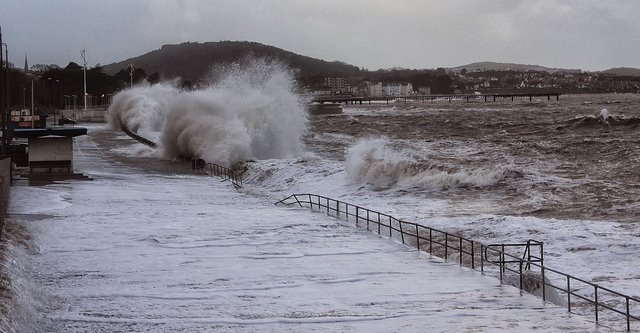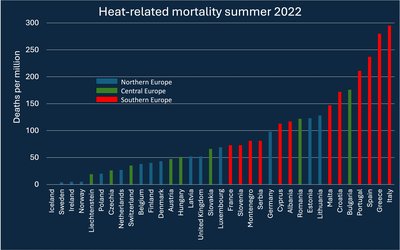
The most relevant hazards for Europe in terms of average annual losses and deaths are heat and cold waves, river and coastal floods, droughts, wildfires and windstorms. The future changes in these hazards in Europe under climate change have been assessed under a business-as-usual scenario of climate change (the so-called SRES A1B scenario):
Heat waves
- Heat waves show a progressive and highly significant increase in frequency all over Europe in near future climate. This increase is most pronounced in Southern Europe, where current 100-year events could occur almost every year in the 2080s. In Southern Europe, up to 60 % of the territory could be annually exposed to a current 100-year heat wave by the end of the century.
Cold waves
- Cold waves show an opposite trend with current cold extremes tending to mostly disappear in Europe in more distant futures. The current 2-year event may occur less than every 100 years by the end of the century almost everywhere in Europe.
Droughts
- Stream flow droughts may become more severe and persistent in Southern and Western Europe: the current 100-year events could occur approximately every 2 to 5 years by 2080 in Southern and Western Europe, respectively. This results from the reduced precipitation and increased evaporative demands with higher temperatures. Northern, Eastern and Central Europe show an opposite tendency with a strong reduction in drought frequency caused by higher precipitation that outweigh the effects of increased evapotranspiration.
Wildland fires
- Most of Europe, especially Western, Eastern and Central regions, could experience an increase in the frequency of extreme wildland fires: current 100-year events will occur every 5 to 50 years by the end of the century. Interestingly, Southern Europe shows a decrease in the frequency of very extreme events, which is likely due to the expected reduction in net primary productivity of terrestrial ecosystem that may limit the fuel availability and, ultimately, the propagation of large wildland fires.
River flood
- Western Europe shows a consistent rise in future river flood hazard: current 100-year events could manifest every ~30 years in 2080s. A modest but significant decrease in river flood frequency is projected in Southern, Central and Eastern regions, in the latter because of the strong reduction in snowmelt induced river floods, which offsets the increase in average and extreme precipitation.
Coastal floods
- Coastal floods show a progressive and pronounced increase in recurrence along Europe’s coastlines chiefly caused by sea level rise: current 100-year events may manifest every 2 to 8 years, or even sub-annually in Eastern Europe, in the 2080s.
Windstorms
- It is highly uncertain how windstorms may change. Projections indicate that areas with increases in windstorm hazard are mainly located in Western, Eastern and Northern Europe, while Southern regions present slight reductions in frequency as observed in previous studies.
Looking at the combination of these 100-year extreme events, results suggest that entire Europe could face a progressive increase in overall climate exposure, with a prominent spatial gradient towards southwestern regions where heat waves, droughts and wildfires are particularly effective.
Potential key hotspots that are potentially prone to an increase in exposure to multiple hazards are mainly located along coastlines and in floodplains where windstorms and floods will be likely relevant in combination with temperature-related hazards. More exposed regions include the British Isles, the North Sea area, north-western parts of the Iberian Peninsula, as well as parts of France, the Alps, Northern Italy and Balkan countries along the Danube River.
Source: Forzieri et al., 2016. Climatic Change 137: 105–119.
Photo: Ashley Perkins (www.flickr.com)








